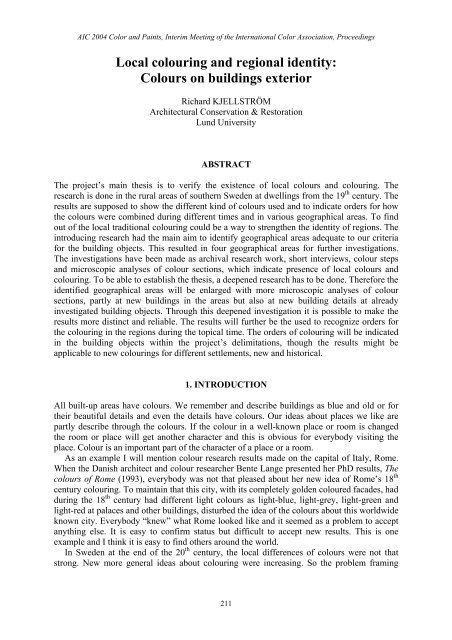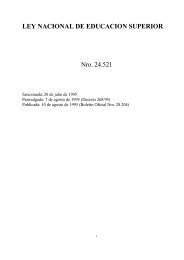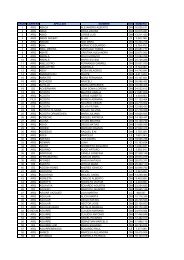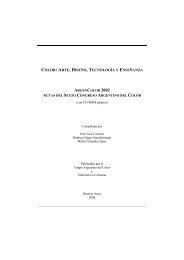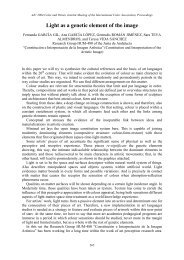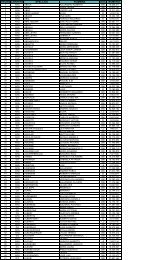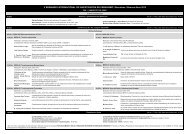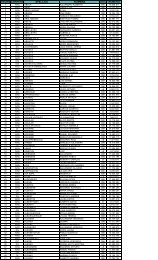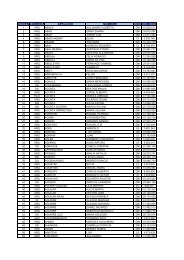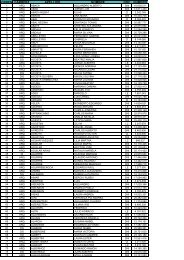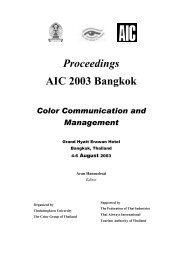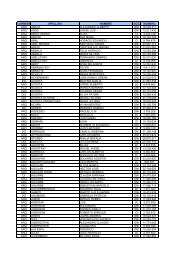Local colouring and regional identity: Colours on buildings exterior
Local colouring and regional identity: Colours on buildings exterior
Local colouring and regional identity: Colours on buildings exterior
You also want an ePaper? Increase the reach of your titles
YUMPU automatically turns print PDFs into web optimized ePapers that Google loves.
AIC 2004 Color <str<strong>on</strong>g>and</str<strong>on</strong>g> Paints, Interim Meeting of the Internati<strong>on</strong>al Color Associati<strong>on</strong>, Proceedings<br />
<str<strong>on</strong>g>Local</str<strong>on</strong>g> <str<strong>on</strong>g>colouring</str<strong>on</strong>g> <str<strong>on</strong>g>and</str<strong>on</strong>g> <str<strong>on</strong>g>regi<strong>on</strong>al</str<strong>on</strong>g> <str<strong>on</strong>g>identity</str<strong>on</strong>g>:<br />
<str<strong>on</strong>g>Colours</str<strong>on</strong>g> <strong>on</strong> <strong>buildings</strong> <strong>exterior</strong><br />
Richard KJELLSTRÖM<br />
Architectural C<strong>on</strong>servati<strong>on</strong> & Restorati<strong>on</strong><br />
Lund University<br />
ABSTRACT<br />
The project’s main thesis is to verify the existence of local colours <str<strong>on</strong>g>and</str<strong>on</strong>g> <str<strong>on</strong>g>colouring</str<strong>on</strong>g>. The<br />
research is d<strong>on</strong>e in the rural areas of southern Sweden at dwellings from the 19 th century. The<br />
results are supposed to show the different kind of colours used <str<strong>on</strong>g>and</str<strong>on</strong>g> to indicate orders for how<br />
the colours were combined during different times <str<strong>on</strong>g>and</str<strong>on</strong>g> in various geographical areas. To find<br />
out of the local traditi<strong>on</strong>al <str<strong>on</strong>g>colouring</str<strong>on</strong>g> could be a way to strengthen the <str<strong>on</strong>g>identity</str<strong>on</strong>g> of regi<strong>on</strong>s. The<br />
introducing research had the main aim to identify geographical areas adequate to our criteria<br />
for the building objects. This resulted in four geographical areas for further investigati<strong>on</strong>s.<br />
The investigati<strong>on</strong>s have been made as archival research work, short interviews, colour steps<br />
<str<strong>on</strong>g>and</str<strong>on</strong>g> microscopic analyses of colour secti<strong>on</strong>s, which indicate presence of local colours <str<strong>on</strong>g>and</str<strong>on</strong>g><br />
<str<strong>on</strong>g>colouring</str<strong>on</strong>g>. To be able to establish the thesis, a deepened research has to be d<strong>on</strong>e. Therefore the<br />
identified geographical areas will be enlarged with more microscopic analyses of colour<br />
secti<strong>on</strong>s, partly at new <strong>buildings</strong> in the areas but also at new building details at already<br />
investigated building objects. Through this deepened investigati<strong>on</strong> it is possible to make the<br />
results more distinct <str<strong>on</strong>g>and</str<strong>on</strong>g> reliable. The results will further be the used to recognize orders for<br />
the <str<strong>on</strong>g>colouring</str<strong>on</strong>g> in the regi<strong>on</strong>s during the topical time. The orders of <str<strong>on</strong>g>colouring</str<strong>on</strong>g> will be indicated<br />
in the building objects within the project’s delimitati<strong>on</strong>s, though the results might be<br />
applicable to new <str<strong>on</strong>g>colouring</str<strong>on</strong>g>s for different settlements, new <str<strong>on</strong>g>and</str<strong>on</strong>g> historical.<br />
1. INTRODUCTION<br />
All built-up areas have colours. We remember <str<strong>on</strong>g>and</str<strong>on</strong>g> describe <strong>buildings</strong> as blue <str<strong>on</strong>g>and</str<strong>on</strong>g> old or for<br />
their beautiful details <str<strong>on</strong>g>and</str<strong>on</strong>g> even the details have colours. Our ideas about places we like are<br />
partly describe through the colours. If the colour in a well-known place or room is changed<br />
the room or place will get another character <str<strong>on</strong>g>and</str<strong>on</strong>g> this is obvious for everybody visiting the<br />
place. Colour is an important part of the character of a place or a room.<br />
As an example I will menti<strong>on</strong> colour research results made <strong>on</strong> the capital of Italy, Rome.<br />
When the Danish architect <str<strong>on</strong>g>and</str<strong>on</strong>g> colour researcher Bente Lange presented her PhD results, The<br />
colours of Rome (1993), everybody was not that pleased about her new idea of Rome’s 18 th<br />
century <str<strong>on</strong>g>colouring</str<strong>on</strong>g>. To maintain that this city, with its completely golden coloured facades, had<br />
during the 18 th century had different light colours as light-blue, light-grey, light-green <str<strong>on</strong>g>and</str<strong>on</strong>g><br />
light-red at palaces <str<strong>on</strong>g>and</str<strong>on</strong>g> other <strong>buildings</strong>, disturbed the idea of the colours about this worldwide<br />
known city. Everybody “knew” what Rome looked like <str<strong>on</strong>g>and</str<strong>on</strong>g> it seemed as a problem to accept<br />
anything else. It is easy to c<strong>on</strong>firm status but difficult to accept new results. This is <strong>on</strong>e<br />
example <str<strong>on</strong>g>and</str<strong>on</strong>g> I think it is easy to find others around the world.<br />
In Sweden at the end of the 20 th century, the local differences of colours were not that<br />
str<strong>on</strong>g. New more general ideas about <str<strong>on</strong>g>colouring</str<strong>on</strong>g> were increasing. So the problem framing<br />
211
AIC 2004 Color <str<strong>on</strong>g>and</str<strong>on</strong>g> Paints, Interim Meeting of the Internati<strong>on</strong>al Color Associati<strong>on</strong>, Proceedings<br />
was, did it exist local <str<strong>on</strong>g>colouring</str<strong>on</strong>g> during the 19 th century at rural dwellings <str<strong>on</strong>g>and</str<strong>on</strong>g> was it the same<br />
colours <str<strong>on</strong>g>and</str<strong>on</strong>g> <str<strong>on</strong>g>colouring</str<strong>on</strong>g> that was possible to see at the end of the 20 th century?<br />
2. METHODS<br />
It is obvious that the colours from the 19 th century are not visible at all <strong>buildings</strong> from this era.<br />
Despite of that the main source to detect the colours are the existing <strong>buildings</strong>. Other sources<br />
as archives, oral sources <str<strong>on</strong>g>and</str<strong>on</strong>g> ic<strong>on</strong>ographic materials are not enough to verify the existing of<br />
local colours <str<strong>on</strong>g>and</str<strong>on</strong>g> <str<strong>on</strong>g>colouring</str<strong>on</strong>g> during the 19 th century <str<strong>on</strong>g>and</str<strong>on</strong>g> can <strong>on</strong>ly be used together with the<br />
main source; colour investigati<strong>on</strong>s at adequate existing <strong>buildings</strong>. An important part in the<br />
beginning of the project was to identify the building objects where the colour secti<strong>on</strong>s could<br />
be made. How is it possible to know where to find building objects with facades covered with<br />
layers of paint c<strong>on</strong>taining old original colours?<br />
Archive studies together with short interviews with building archaeologists made it<br />
possible to find areas with adequate building objects. Next step was to make ocular<br />
investigati<strong>on</strong>s in the suggested areas to find out if the building objects were from the<br />
delimited period of the project. Details such as the plaster, the shape of the profiles from the<br />
wooden panels <str<strong>on</strong>g>and</str<strong>on</strong>g> the type of nails used, determine whether the facades could c<strong>on</strong>tain<br />
desirable layers of paint or not. When areas with relevant building objects were defined the<br />
colour investigati<strong>on</strong> could start in four separate geographic areas.<br />
The most applicable method in this project was to make microscopic analyses of colour<br />
secti<strong>on</strong>s, this because of the small injury at the facades. Colour steps, the other c<strong>on</strong>ceivable<br />
method, makes to much injury at the facades. Of course, it is important to use a method with<br />
the lowest injury at the facade because the objects are private property. The colour secti<strong>on</strong>s<br />
cut out of the facades are about 5 × 5 mm <str<strong>on</strong>g>and</str<strong>on</strong>g> into the underlying building material. When the<br />
secti<strong>on</strong>s are examined the other sources are used together to make the results more reliable.<br />
The most interesting source is part of the ic<strong>on</strong>ographic sources: wall paintings. In <strong>on</strong>e of the<br />
geographic area the wall paintings are of great interest for defining the colours at old layers of<br />
paint. Parts of the wall paintings show the facades of the farms when they were new-built<br />
(Figure 1). This has been an important part together with the colour secti<strong>on</strong>s in defining the<br />
original colours at the facades where the wall paintings existed.<br />
Figure 1. Wall painting from the farm, Hemmingsmåla, Blekinge, Sweden. This wall painting<br />
shows the <strong>exterior</strong> colours of the building complex when it was new-built in 1849.<br />
212
AIC 2004 Color <str<strong>on</strong>g>and</str<strong>on</strong>g> Paints, Interim Meeting of the Internati<strong>on</strong>al Color Associati<strong>on</strong>, Proceedings<br />
3. RESULTS<br />
The general ideas of the <str<strong>on</strong>g>colouring</str<strong>on</strong>g> at traditi<strong>on</strong>al <strong>buildings</strong> in Sweden today can sometimes be<br />
simplified. This can be seen very clear at the results from this project. For example, at the<br />
south coast in Sweden today the farmer’s dwellings are white, traditi<strong>on</strong>ally from white<br />
limewash. And this is an accepted idea of a typical traditi<strong>on</strong>al <str<strong>on</strong>g>colouring</str<strong>on</strong>g> in this area. But the<br />
results from this investigati<strong>on</strong> present all colours but white <strong>on</strong> the facades at these dwellings.<br />
The <strong>buildings</strong> are from the middle of the 19 th century <str<strong>on</strong>g>and</str<strong>on</strong>g> have almost similar details at the<br />
facades; it is a very well defined group of <strong>buildings</strong>. Some of the dwellings have been painted<br />
red or green since they were built in the middle of the 19 th century until the 1960s, but today,<br />
after forty years, the knowledge is already forgotten.<br />
Figure 2. This detail of a plastered facade, from a farmer’s house in the coastal regi<strong>on</strong> of<br />
southern Sweden, shows many of the old layers of paint in many different colours.<br />
The results from the fishermen villages in the same geographic area are totally different<br />
from the results at the farmer’s dwellings. The absolutely most comm<strong>on</strong> colour at the facades<br />
of the fishermen’s dwellings during the 19 th century is white limewash. In the other<br />
geographical areas the results show the same appearing of lost c<strong>on</strong>tact with the original<br />
<str<strong>on</strong>g>colouring</str<strong>on</strong>g>. At the same <strong>buildings</strong> the most comm<strong>on</strong> colour at the window frames are green<br />
<str<strong>on</strong>g>and</str<strong>on</strong>g> it seems like it is the same colour as the boats. During the 19 th century these poor fishing<br />
villages at the south coast in Sweden painted the dwellings in the most simplified way: with<br />
white limewash <str<strong>on</strong>g>and</str<strong>on</strong>g> rests from the paint to the boats.<br />
The <strong>on</strong>ly traditi<strong>on</strong>al pigment produced in Sweden today is a red-oxide pigment. This is still<br />
very comm<strong>on</strong> at rough wooden panelling <str<strong>on</strong>g>and</str<strong>on</strong>g> it is a str<strong>on</strong>g symbol for rural <strong>buildings</strong> in<br />
Sweden. In the southern coastal regi<strong>on</strong> of Sweden this pigment is not used. Therefore this<br />
area was the most relevant to make investigati<strong>on</strong>s about local characteristics in <str<strong>on</strong>g>colouring</str<strong>on</strong>g> in<br />
Sweden during the 19 th century. Another aim with the investigati<strong>on</strong> was to find out of<br />
forgotten local producti<strong>on</strong> of pigments.<br />
One of the geographic areas studied in the project is surrounded by the comm<strong>on</strong> red<br />
painted facades. This area was very wealthy in the first half of the 19 th century. New facades<br />
with planed wooden panelling were erected with mouldings, cornices <str<strong>on</strong>g>and</str<strong>on</strong>g> other costly details.<br />
Through the colour secti<strong>on</strong>s made at these facades it is possible to detect oil paint in lightgreen,<br />
light-red <str<strong>on</strong>g>and</str<strong>on</strong>g> light-grey. Before this period of expansi<strong>on</strong> all the <strong>buildings</strong> in the regi<strong>on</strong><br />
were made with visible wooden c<strong>on</strong>structi<strong>on</strong>s <str<strong>on</strong>g>and</str<strong>on</strong>g> just tared or painted with the comm<strong>on</strong> red<br />
paint.<br />
213
AIC 2004 Color <str<strong>on</strong>g>and</str<strong>on</strong>g> Paints, Interim Meeting of the Internati<strong>on</strong>al Color Associati<strong>on</strong>, Proceedings<br />
Another local <str<strong>on</strong>g>colouring</str<strong>on</strong>g> is at the isl<str<strong>on</strong>g>and</str<strong>on</strong>g> Öl<str<strong>on</strong>g>and</str<strong>on</strong>g> in the Baltic Sea. The investigated dwellings<br />
in this geographic area are architect<strong>on</strong>ic of the same type as the <strong>on</strong>e in the previous example.<br />
The facades are developed from the 18 th century’s vicarage <str<strong>on</strong>g>and</str<strong>on</strong>g> manor houses. The main<br />
difference from the dwelling described before is that they were not panelled. Details as<br />
cornices, mansard roof <str<strong>on</strong>g>and</str<strong>on</strong>g> detailed main entrances were the same. A comm<strong>on</strong> way to protect<br />
the wooden c<strong>on</strong>structi<strong>on</strong> was to give it a tar coating. Some of these facades were panelled in<br />
the early 20 th century but it is still possible to find these building almost black from tar. From<br />
colour secti<strong>on</strong>s made <strong>on</strong> the facades that were later panelled it is detected that the <str<strong>on</strong>g>colouring</str<strong>on</strong>g><br />
was homogeneous with tared wood, white window frames <str<strong>on</strong>g>and</str<strong>on</strong>g> polychrome main entrances.<br />
Figure 3. This dwelling is from the beginning of the 19 th century, with the wooden<br />
c<strong>on</strong>structi<strong>on</strong> visible <str<strong>on</strong>g>and</str<strong>on</strong>g> tared. Together with the white windows <str<strong>on</strong>g>and</str<strong>on</strong>g> polychrome main<br />
entrance, it is a typical local <str<strong>on</strong>g>colouring</str<strong>on</strong>g> at Öl<str<strong>on</strong>g>and</str<strong>on</strong>g> during the period.<br />
4. PURPOSE AND APPLICATIONS<br />
Of course, <str<strong>on</strong>g>colouring</str<strong>on</strong>g> is a process with changes over time as architecture itself, but the<br />
knowledge about the traditi<strong>on</strong>al <str<strong>on</strong>g>colouring</str<strong>on</strong>g> <str<strong>on</strong>g>and</str<strong>on</strong>g> perhaps of orders in how to combine colours is<br />
of great interest for the <str<strong>on</strong>g>colouring</str<strong>on</strong>g> of both the traditi<strong>on</strong>al <str<strong>on</strong>g>and</str<strong>on</strong>g> new <strong>buildings</strong> today. As I have<br />
tried to show, there are examples of local <str<strong>on</strong>g>colouring</str<strong>on</strong>g> still used <str<strong>on</strong>g>and</str<strong>on</strong>g> of <str<strong>on</strong>g>colouring</str<strong>on</strong>g> that is partly<br />
forgotten or will be in a couple of years. The main purpose with this project is to establish a<br />
knowledge about the local <str<strong>on</strong>g>colouring</str<strong>on</strong>g> at traditi<strong>on</strong>al <strong>buildings</strong>. The orders of local <str<strong>on</strong>g>colouring</str<strong>on</strong>g><br />
from the 19 th century show the many possibilities colour gives architecture.<br />
Another idea is that this project is applicable at any place around the world <str<strong>on</strong>g>and</str<strong>on</strong>g> can make<br />
focus <strong>on</strong> the original local <str<strong>on</strong>g>and</str<strong>on</strong>g> <str<strong>on</strong>g>regi<strong>on</strong>al</str<strong>on</strong>g> <str<strong>on</strong>g>colouring</str<strong>on</strong>g> in specific places where a similar<br />
investigati<strong>on</strong> can be d<strong>on</strong>e. To detect the local <str<strong>on</strong>g>colouring</str<strong>on</strong>g> makes the traditi<strong>on</strong>al architecture<br />
more locally characteristic <str<strong>on</strong>g>and</str<strong>on</strong>g> strengthen the relati<strong>on</strong> to the local populati<strong>on</strong>.<br />
REFERENCE<br />
Lange, B. 1993. The colours of Rome. Copenhagen: The Royal Danish Academy of Fine Arts.<br />
Address: Richard Kjellström, Architectural C<strong>on</strong>servati<strong>on</strong> & Restorati<strong>on</strong><br />
Lund University, Box 118, S-221 00 Lund, Sweden<br />
E-mail:<br />
214


